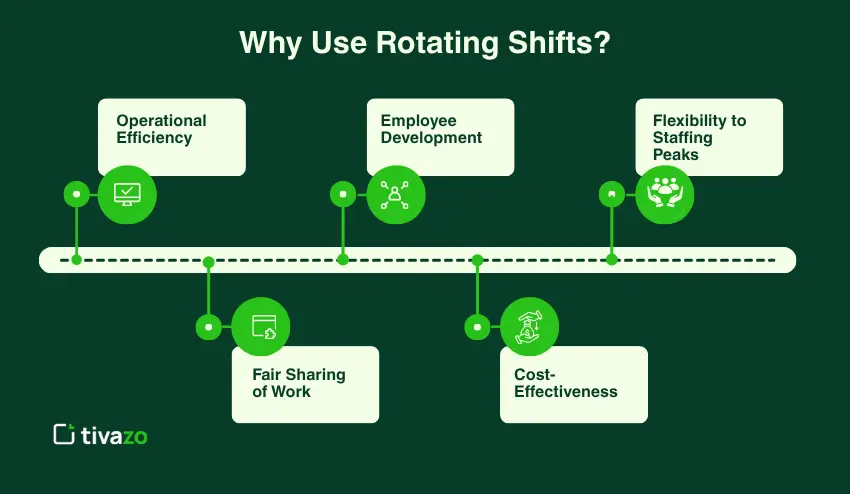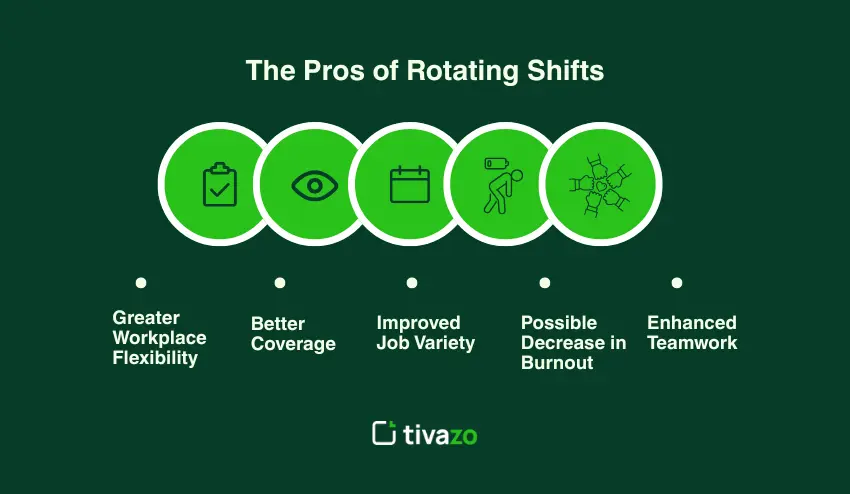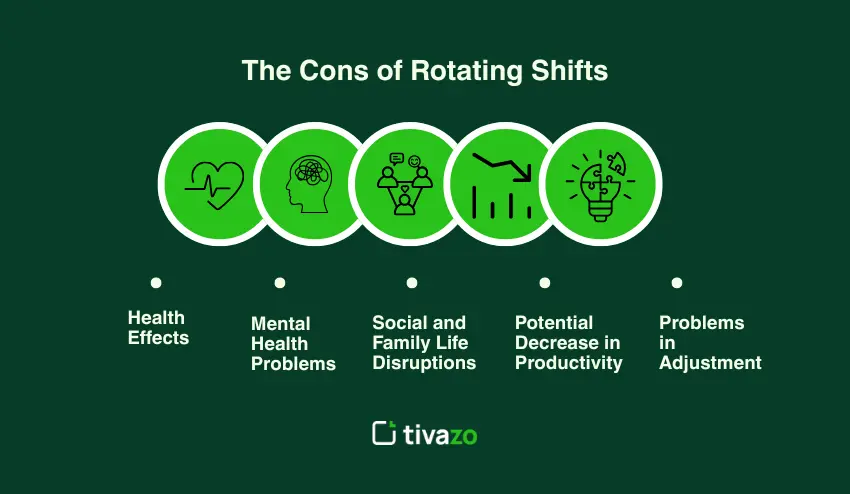Rotating shifts are now an everyday aspect of the contemporary work life, particularly in sectors that necessitate 24/7 work. In the context of healthcare and manufacturing, as well as transportation and customer support, numerous employees have to alternate between day, evening, and night shifts. Although this method of scheduling allows businesses to remain in operation, this may be a difficult task to the employees who have to adjust to odd schedules.
It is important that workers and employers understand how rotating shifts operate, why they are implemented and how they might affect health and productivity. To employees, it refers to seeking mechanisms of sustaining energy, concentration, and work-life balance. In the case of organizations, it entails coming up with fair, efficient and sustainable shift schedules.
This manual plunges into the realm of rotating shifts. We will discuss the kind of schedules, the people who usually work them, their operation, and the advantages and disadvantages. At the conclusion, you will have a practical experience and tips on how to make cycle shifts more time-saving and effective, both as a shift worker and as an employer who schedules shifts.
What Are Rotating Shifts?
Rotating shifts are work schedules where the employees rotate through various shifts in a given period of time as opposed to working in the same hours daily. These rotations typically involve a combination of day, evening and night shifts. The rotation may be carried out either on a daily basis, weekly or even on a bi-weekly basis based on the requirements of the organization. The primary objective is to make sure that 24/7 operations are being conducted with ease and work is equally divided among the staff.
Rotating shifts are common in such industries as healthcare, manufacturing, transportation, and customer service. Hospitals, for instance, have rotating schedules to ensure that patients are attended to at all times, whereas factories that run around the clock have employees who work in shifts to keep the production going. Even the global customer support teams shift to ensure that a large number of time zones are covered effectively.
Work rotation are not merely a scheduling instrument, but they influence the way employees handle their sleep, energy, and personal life. It is important to know how they operate to reduce fatigue, ensure productivity and enhance overall well-being. The employees and employers who understand the principles of rotating schedules are able to come up with schedules that are more balanced in relation to the needs of the human beings and the demands of the operations.
Types of Rotating Shifts
Rotating shifts will be used to balance the operational requirements and equity to the employees. They enable employees to work in various shifts so that no individual employee would be working in the same shift too long. Learning about the nature of rotating schedules can assist employees to adapt to their schedules and employers develop effective schedules.
- Frequent Rotation is changing shifts on a regular basis, usually on a daily basis, every two or three days. Although it does not leave anyone on an unwanted shift too long, it may be demanding to the sleeping patterns, since the body may not have much time to adapt.
- Slow Rotation changes shift a weekly or bi-weekly. This allows employees to get used to each shift and they will feel less tired and better focused but some shifts will seem longer since they are not as desirable.
- Weekend Rotation spreads weekend work equally among employees. This system is used in industries such as healthcare, hospitality, and customer service to ensure they provide coverage besides providing employees with reasonable access to weekends.
- Partial Rotation is only applicable to certain shifts usually night shifts or late evening shifts with other shifts being constant. This will be more fair and stable, especially in work places where only some of the shifts are difficult or unpopular.
Examples of Rotating Shift Schedules are:
- DuPont Schedule: In DuPont schedule 12-hour shifts, 4 weeks rotation, workdays and rest days are mixed together to avoid burnout.
- Pitman Schedule: This is a 2-2-3 schedule that provides 12-hour shifts and alternating workdays, which is common in manufacturing.
- 24-48 Schedule: This is a 24-hour shift that is followed by 48 hours off so that employees can work in hospitals and emergency departments.
- 4-3 Schedule: This is a four-day on, three-day off, moderate schedule used in healthcare and production plants.
Knowing these types of shifts, the employees will be able to plan their routine, and the employers will be able to design schedules that will reduce fatigue and still be productive.
Who Uses Rotating Shifts?
The alternating shifts are usually used in the industries that are 24-hour or in those industries that need to be covered in various time zones. They guarantee constant working processes and allocate work equally among the employees.
Medical Workers such as nurses, physicians, and emergency services often work on shifts to give 24/7 care to patients. These schedules are used by hospitals to cover the morning, evening, nights, and weekends.
Rotating shifts are commonly used in manufacturing and Production Workers and are common in 24/7 factories. Rotation schedules are used to ensure that there is always the same level of production without having to overwork a given group of employees.
There are Transportation and Logistics staffs such as truck drivers, pilots, train operators, and airport workers who make shifts so that they can have operations on time and in various hours and areas.
Global companies have Customer Support Teams who rotate shifts so as to serve customers in various time zones so that they can have seamless services even when the business is not in its normal working hours.
There are also guards and monitoring personnel who change shifts to ensure that there is round-the-clock security and guarding.
Workers in the hospitality industry of hotels, resorts and restaurants work in shifts to ensure that the peak hours are covered and the service is offered 24 hours.
Why Use Rotating Shifts?
Organizations use rotating shifts due to a number of practical reasons, trying to combine both operational requirements with fairness towards employees:

- Operational Efficiency: Rotating shifts provide the 24/7 operation in the sectors of healthcare, manufacturing, and transportation. This is done through continuous operations without overloading of a given employee.
- Fair Sharing of Work: The companies can distribute desirable and less desirable shifts equally among the employees by rotating shifts thus avoiding burnout and resentment.
- Employee Development: This can be done by exposing employees to various shifts to ensure that they have diverse experience, develop new skills and enhance flexibility.
- Cost-Effectiveness: These shifts eliminate overtime or temporary staffing, which help organizations to save on labor costs.
- Flexibility to Staffing Peaks: Rotation enables companies to effectively cover the peak hours without depriving employees a regular rest time.
The strategic application of rotating shifts can assist companies to achieve productivity, equity, and worker well-being at the same time.
The Pros of Rotating Shifts
Rotating shifts have several advantages to both employee and the organization especially when schedules are arranged in a well-organized and balanced manner.

- Greater Workplace Flexibility: Rotating shifts will enable employees to work across different time periods. This flexibility can make sure that the operations do not stop and provide the staff with additional opportunities to juggle between personal and job responsibilities.
- Better Coverage: Constant coverage is imperative in such industries as healthcare, manufacturing, logistics, and customer support. These shifts will provide that the shifts will be fully staffed and there will be no service or production interruptions.
- Improved Job Variety: The different shift work also subjects employees to different tasks, environments, and duties. This diversity helps to avoid boredom and monotony and keeps the employees active and motivated. It is also capable of building wider skills sets since employees will learn to cope with various challenges.
- Possible Decrease in Burnout: Sharing of the undesirable shifts among the staff will help avoid overloading of the individual employees. When the employees are rotated properly, they will not feel tired, mentally stressed, or frustrated by the necessity to work throughout the difficult hours such as nights or weekends.
- Enhanced Teamwork: Rotating shifts enables the employees to work with other employees with time. This facilitates sharing of knowledge, teamwork and may be used to create a more unified and flexible workforce.
Rotating shifts can be an effective way of balancing the needs of the organization and the well being of the employees to provide a work environment that is both productive and satisfying when managed appropriately.
The Cons of Rotating Shifts
Despite the numerous benefits that the rotating shifts are related to, they also have a range of challenges that may impact health, productivity and social life when they are not addressed carefully.

- Health Effects: When someone deviates from their regular schedule, this can throw off the body’s natural circadian rhythms leading to sleep difficulties, tiredness, digestive issues and possible longer-term cardiovascular consequences.
- Mental Health Problems: The new work schedules which keep on changing can lead to stress and anxiety as well as irritability. Employees will tend to have mood swings or a lack of concentration both in work and personal life.
- Social and Family Life Disruptions: Rotating schedules can lead to an issue of relationship, social events or family duties, which can lead to isolation.
- Potential Decrease in Productivity: Fatigue and disturbed sleep can result in slow response times, mistakes and reduced productivity in general. The employees may require more time to take a break after the night or consecutive shifts.
- Problems in Adjustment: There are those who find it difficult to adjust to constant changes particularly when the direction of rotation is high or in a direction that does not conform to the natural sleep patterns.
Understanding of these problems can guide employees and employers to implement some mechanisms, including forward rotation, regular sleep patterns, and wellness programs to minimize the negative effects and still reap the benefits of rotating shifts.
Best Practices for Managing Rotating Shifts
A rotating shift could be more sustainable and less stressful to the employees with proper planning and management. The best practices will ensure productivity and safeguard health and well-being.
- Forward Rotation: Shifts to turn clockwise- day to evening to night. This is more in line with the natural circadian rhythms of the body, and it is less difficult to adapt to it and less likely to be fatigued.
- Regular Sleep Routine: This should be promoted to employees to have regular sleep patterns even during off days. It is possible to use blackout curtains, sleep mask, or white noise to enhance the quality of sleep.
- Lifestyle Healthy Behaviors: Dietary habits, body exercises, and stress management strategies will allow employees to overcome the challenge of rotating schedules. Recovery is also promoted by staying hydrated and not taking too much caffeine or alcohol prior to sleep.
- Good Communication: Communication should be effective and timely regarding schedules, change of shift, and expectations so that employees can plan. This minimizes misunderstandings, work pressure, and workflow mistakes.
- Track Workload and Rest Periods: Do not have too many successive night shifts and have enough shifts between them. This reduces fatigue and keeps the employees going.
Through these practices, employees will be able to adjust to rotating shifts easier and employers will be able to operate efficiently without affecting the health of the workers.
Employer Strategies to Support Shift Workers
The role of employers in ensuring rotating shifts are manageable and sustainable is very important. The well-being, productivity, and retention of employees can be improved with the help of supportive strategies.
- Health and Wellness Programs: Offer the materials that may help employees handle physical and psychological stresses of working on shifts. The programs can include fitness plans, nutrition tips and stress management workshops.
- Flexible Work Rules: Grant some level of control to employees on their working schedules whenever possible. Flexibility will increase job satisfaction and could reduce absenteeism.
- Regular Health Inspections: Examine the condition of the shift workers to identify and address any potential issues at the initial level. Particularly, it is beneficial to monitor sleep disorders, fatigue, or cardiovascular problems regularly.
- Flexible Work Schedule: Develop an atmosphere of sympathy amongst the employees who do not work during the regular working hours. Encourage teamwork, communication, and understanding of the challenges that shift workers must face.
- Training and Resources: Train time management, sleep hygiene and night or irregular shift coping strategies. Access to educational materials and tools helps employees to adjust better.
By making an investment in these strategies, the organization will be efficient in its operation and will also have a healthier and more satisfied workforce.
Conclusion
Rotating shifts are an obligatory feature of most industries, which guarantees constant work and equal allocation of labor. Although they are accompanied by their problems, such as sleep disturbances, health hazards, and social consequences, knowing their mechanisms of operation and applying effective measures can make them controllable.
Rotating shifts may be advantageous to organizations and employees by selecting the appropriate rotation patterns, practicing the best practices, and assisting employees with wellness programs and flexible schedules. Productivity and well-being of workers and operational efficiency and fairness of businesses are maintained.
It is all about balance whether you are an employee and you are trying to work around varying schedules or an employer trying to work out the shift rotations. Rotating schedules can be effective with the proper planning and support without affecting health or job satisfaction.




